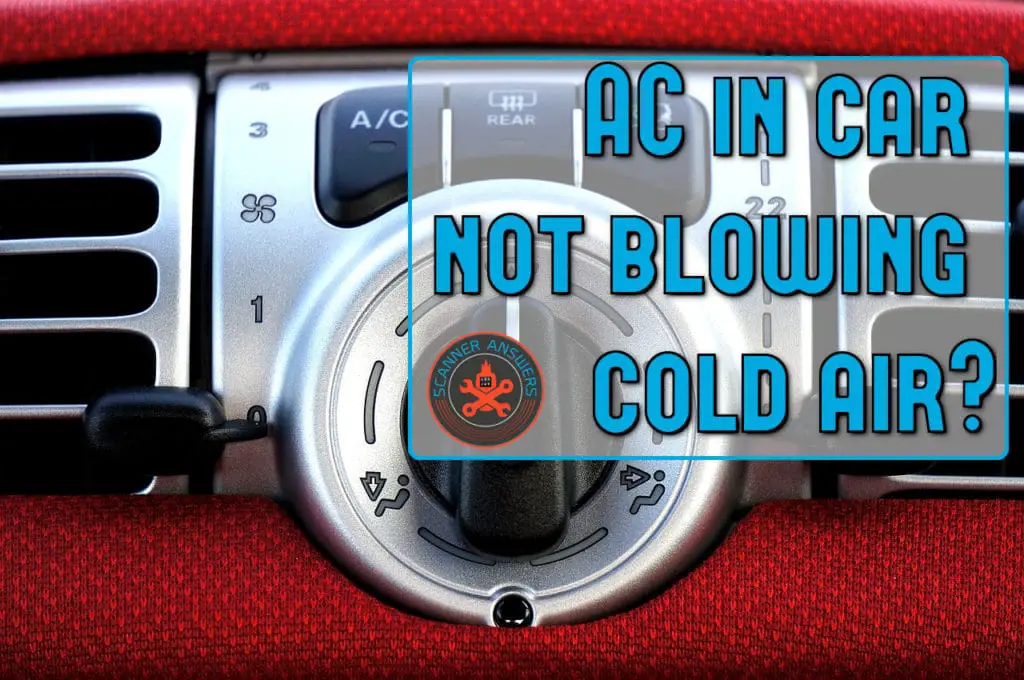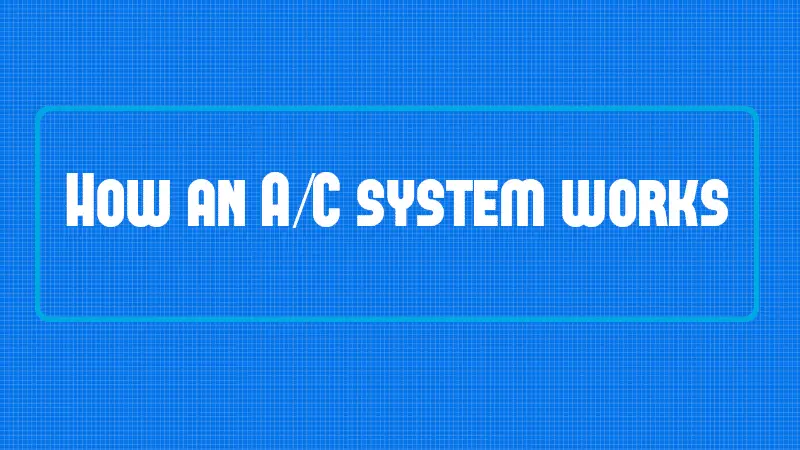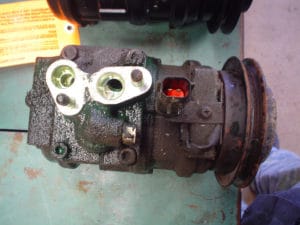
Car A/C Not Blowing Cold Air After Recharging the System
Hi my name is Matt.
The other day I found that the AC in my car not blowing cold air like it used to when I bought it. So, I figured I’d write a quick article to help any of you that may be dealing with a vehicle AC not blowing cold air after recharge.

It used to be that car air conditioning systems were standard equipment only in expensive luxury marquees. But nowadays, even the cheapest small cars are equipped with standard A/C from the factory. If the A/C in your vehicle is well-maintained and serviced regularly, you can expect it to continuously cool the cabin when you need it most. But there are times the air conditioner will not blow cold air even after recharging the system.
What could have gone wrong? To get right to the point and save you time if you are in a hurry, here is a list of the 6 most common reasons why your car’s A/C is not blowing cold air after a recharge:
- Leakage
- Improper Recharge
- Faulty Compressor
- Condenser Issues
- Expansion Valve or Orifice Tube Issues
- Electrical Issues
If you’d like to learn more details about the signs and symptoms of these issues, other, less common causes, and the cost to repair the problem, keep reading below!
In order to fully understand the possible cause of charged ac still warm, it is important to understand how an air conditioning system works.

The Basic Principles of Car Air Conditioning
The main goal of the vehicle A/C is to cool or lower the temperature of the surrounding air. It does this by reducing the moisture content of the air, which is lowering the relative humidity so to speak. Hot air is filled with moisture. Colder air is dryer. The air conditioning system will absorb the air inside the cabin, remove or lessen the humidity, and blow the cooler air via the air vents.
It all sounds simple, right? The main principles in a typical air conditioning system are evaporation, condensation, compression, and expansion. The main parts of an A/C are the following:
1. Refrigerant or Freon
If your car A/C not blowing cold air consistently, the first thing to check is the refrigerant level.
The refrigerant is the fluid that passes around the entire A/C system. It can evaporate at lower temperatures and condense into liquid form when exposed to high pressure. The A/C in your vehicle is a sealed system. Any loss of refrigerant can be attributed to leaks in the system. Remember that Freon doesn’t fade – it leaks away. If the A/C is constantly low on refrigerant and is constantly blowing hot air, check for leaks.
Read more about Freon here.

2. Compressor
If your car A/C stopped blowing cold air all of a sudden, it’s likely your compressor needs to be replaced.
The compressor is the engine that drives the entire A/C system. If the compressor is not working or is lacking in oil, it has a tendency to break down and cause the entire system to fail. This results in an inoperative A/C and a steaming hot cabin.
Replacing a vehicle A/C compressor will set you back about $500-$800 dollars including labor. Source.
3. Condenser
The condenser is utilized to convert the refrigerant from vapor to liquid. High amounts of pressure is required to condense the vapor. When this happens, large volumes of heat is produced. The condenser will remove the heat by utilizing the ambient air blowing in the front of the vehicle, or via the fan that also cools the radiator.
4. Receiver/dryer
After the refrigerant condenses, it is passed on to the receiver or dryer. It is a small canister located in the engine bay. The job of the dryer is to remove any moisture from the refrigerant. Excess moisture is harmful to the A/C and can cause a variety of problems such as blockages and damage to mechanical parts.
5. Expansion valve
The refrigerant will then flow to the expansion valve. The expansion valve will remove the pressure from the liquid refrigerant. This allows the Freon to expand and convert back to vapor as it is sprayed into the evaporator.
6. Evaporator
The refrigerant will now pass the evaporator. It is here that the low-pressure Freon will vaporize and absorb the heat from the passenger cabin. The blower fan will push air over the evaporator to recirculate the colder air. The compressor will draw out the refrigerant vapor and convert the low-pressure vapor into high-pressure liquid and the process will repeat continuously.
I know it’s a lot to absorb, but knowing the working components will make it easier to find out why the car AC is not blowing cold air sometimes.

Why is my vehicle A/C still blowing hot air?
For starters, if there was a problem with the system from the very beginning, you can’t expect the A/C to work just by simply recharging or adding Freon inside the system. This is a common misconception that needs to be addressed.
Of course, if your car AC stops blowing cold air after a while the first thing you should check is to make sure you’re not low on refrigerant. If you’ve made sure the vehicle AC system is fully charged, then these are the next common components that cause a hot A/C system even after recharging it with Freon:
- [All Halogenated Gas] Freon leak detector triggers on R22, R134A, R404A, R410A, R1234YF and all halogenated refrigerants including HFCs, CFCs,HCFCs and blends.
- [7 Adjustable Sensitivity] Turn the knob to open and choose the sensitivity level. Maximum sensitivity up to 0.21oz/yr, which is enough to self -check auto AC or air conditioning and other.
- [Multiple Indicators] Equipped with Audible and Visual gas leakage indicators and dual battery indicators.
Faulty compressor
If the compressor is not working, no amount of refrigerant will be able to restore the efficiency of the A/C. A faulty compressor can be caused by age and wear, but electrical problems can also cause an inoperative compressor. The main OBD2 error code for this issue is P0645, but codes P0531 and P0534 will also sometimes appear. If you turn on the A/C switch, the compressor should come to life immediately. If not, either the compressor is broken and would need to be replaced, or there are faulty wirings preventing the compressor from powering up.
Car AC compressors usually last 10 years (source). So if your car is older than 2013 and the compressor hasn’t been replaced, this is likely the reason your system is blowing hot air.
Want to replace the compressor yourself? Watch this video from ScottyBroken cooling fan
A broken cooling fan will not only cause the A/C to blow hot air, but it will also lead to engine overheating. P0480 is the primary error code for a malfunctioning cooling fan. The condenser is bolted to the exact same location of the radiator. If the cooling fan is not working, the condenser will not be successful in getting rid of the excess heat in the Freon. The result? The air conditioning will not blow cold air to the cabin.
Refrigerant leaks
If the A/C works okay then gradually blows hot air after recharging, you might be dealing with refrigerant leaks. The safest and effective way to find leaks is to vacuum the system. Take your car to a qualified technician to have the system diagnosed. It is generally advised to purge and vacuum the system before recharging to detect leaks beforehand.
Dirty system
The evaporator is prone to accumulating large amounts of dirt and debris. This is the reason why the entire system should be flushed and cleaned every few years. Cleaning the A/C is not just a matter of spraying the air vents with pressurized air. You will need to take the vehicle to an expert garage for servicing. The process will usually involve pulling out the evaporator from under the dashboard and cleaning the serviceable parts. The cost for this service ranges from $150 – $300 for most vehicles. The technicians will also check the expansion valve, the level of oil and refrigerant in the system, and adjust the thermostat when needed.
These auto air conditioning troubleshooting tips should be enough to fix 80% of common A/C issues.
Conclusion
If the A/C is blowing hot air, recharging the system should do the trick. But if the car air conditioner is still blowing hot air after recharging, it is best to have a professional diagnose the problem.

